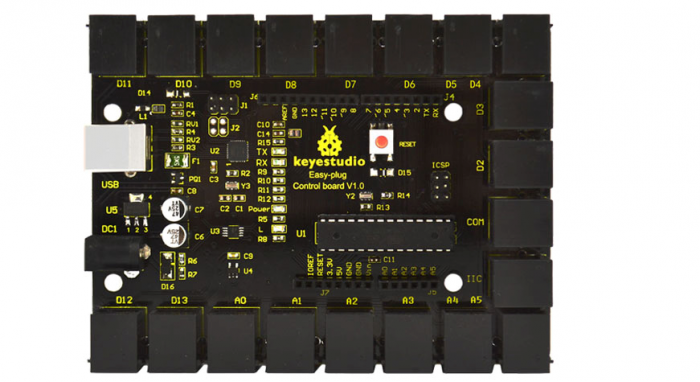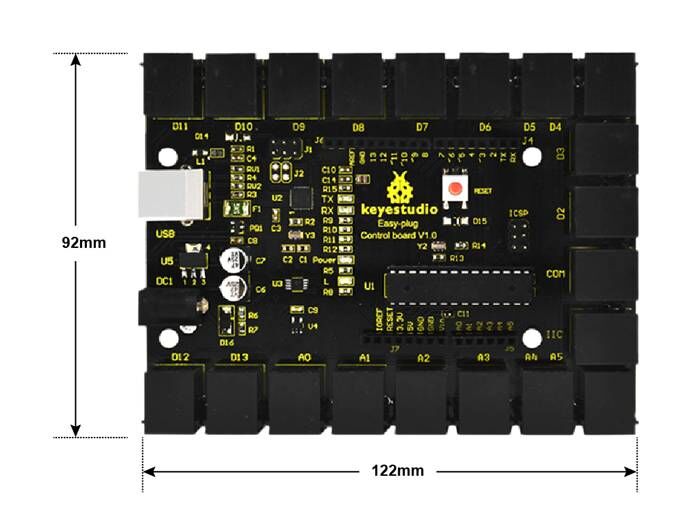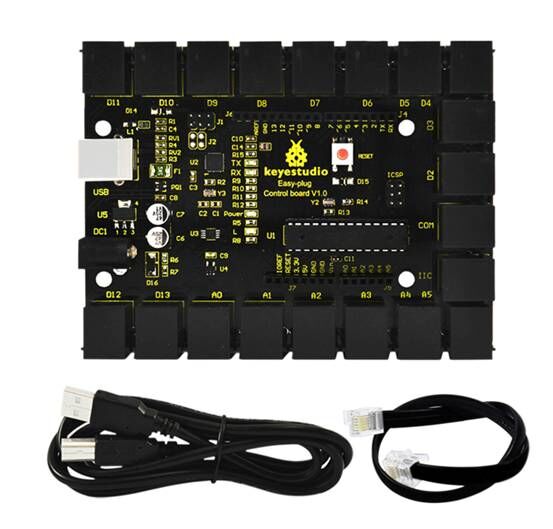Ks0099 keyestudio EASY plug Control Board: Difference between revisions
Keyestudio (talk | contribs) No edit summary |
Keyestudio (talk | contribs) No edit summary |
||
| (7 intermediate revisions by the same user not shown) | |||
| Line 1: | Line 1: | ||
[[image:ks0099-1.png|thumb|700px|right|Keyestudio EASY plug Control Board V1.0]] | |||
<br> | |||
==Introduction== | ==Introduction== | ||
Keyestudio Easy-plug control board is a microcontroller board based on the ATmega328P-PU ([http://www.atmel.com/images/Atmel-8271-8-bit-AVR-Microcontroller-ATmega48A-48PA-88A-88PA-168A-168PA-328-328P_datasheet_Complete.pdf datasheet]). It has 14 digital input/outputs (of which 6 can be used as PWM outputs), 6 analog inputs, a 16 MHz quartz crystal, a USB connection, a power jack, an ICSP header and a reset button. <br> | |||
It contains everything needed to support the microcontroller; simply connect it to a computer with a USB cable or power it with a AC-to-DC adapter or battery to get started. <br> | |||
For convenience of wire connection, we simplify the pins GND and VCC into each plug, so you only need one RJ11 6P6C connector wire to connect a module, no need to separately connect the VCC and GND. <br> | |||
The pins on the original UNO are all redesigned into plug interface. On the board, you can find ports D2-D13, A0 to A5, an IIC port and a COM port. All in one simple plug.<br> | |||
'''Note:''' you should use the RJ11 6P6C connector wire to connect other modules to the board. <br> | |||
<br> | |||
== Specifications == | == Specifications == | ||
{| class="wikitable" cellpadding="1" cellspacing="1" | {| class="wikitable" cellpadding="1" cellspacing="1" | ||
|- | |- | ||
! scope="row" | Microcontroller | ! scope="row" | '''Microcontroller''' | ||
| ATmega328P-PU | | ATmega328P-PU | ||
|- | |- | ||
! scope="row" | | ! scope="row" | '''Operating Voltage''' | ||
| | | 5V | ||
|- | |- | ||
! scope="row" | | ! scope="row" | '''Input Voltage (recommended)''' | ||
| | | DC7-12V | ||
|- | |- | ||
! scope="row" | | ! scope="row" | '''Digital I/O Pins''' | ||
| 14 (of which 6 provide PWM output) | |||
|- | |- | ||
! scope="row" | Digital | ! scope="row" | '''PWM Digital I/O Pins''' | ||
| | | 6 (D3, D5, D6, D9, D10, D11) | ||
|- | |- | ||
! scope="row" | Analog | ! scope="row" | '''Analog Input Pins''' | ||
| 6 | | 6 | ||
|- | |- | ||
! scope="row" | | ! scope="row" | '''DC Current per I/O Pin''' | ||
| 20 mA | | 20 mA | ||
|- | |- | ||
! scope="row" | | ! scope="row" | '''Flash Memory''' | ||
| 32KB (ATmega328) of which 0.5 KB used by bootloader | | 32KB (ATmega328) of which 0.5 KB used by bootloader | ||
|- | |- | ||
! scope="row" | SRAM | ! scope="row" | '''SRAM''' | ||
| 2KB | | 2KB | ||
|- | |- | ||
! scope="row" | EEPROM | ! scope="row" | '''EEPROM''' | ||
| 1 KB | | 1 KB | ||
|- | |- | ||
! scope="row" | | ! scope="row" | '''Clock Speed''' | ||
| 16 MHz | | 16 MHz | ||
|} | |} | ||
<br> | <br> | ||
==Details== | |||
* '''PCB Dimensions:''' 122mm x 92mm x 18mm | |||
* '''Weight:''' 90g | |||
[[Image:KS0099-1.jpg|800px|frameless]]<br> | |||
<br> | |||
==Element and Interfaces== | |||
Here is an explanation of what every element and interface of the board does: | |||
[[Image:ks0099- pinout.jpg|800px|frameless]]<br> | |||
<br> | |||
==Specialized Functions of Some Pins== | |||
* '''SPI communication:''' D10 (SS), D11 (MOSI), D12 (MISO), D13 (SCK). | |||
* '''IIC communication:''' A4 (SDA); A5(SCL) | |||
* '''Serial communication:''' Digital pins 0 (RX) and 1 (TX). | |||
* '''PWM (Pulse-Width Modulation):''' D3, D5, D6, D9, D10, D11 | |||
* '''External Interrupts:''' D2 (interrupt 0) and D3 (interrupt 1). These pins can be configured to trigger an interrupt on a low value, a rising or falling edge, or a change in value. | |||
* '''SPI communication:''' D10 (SS), D11 (MOSI), D12 (MISO), D13 (SCK). These pins support SPI communication using the SPI library. | |||
* '''IIC communication:''' A4 (SDA); A5(SCL) | |||
<br> | |||
==Detailed Use with ARDUINO Software as follows:== | |||
===Step1 | Download the Arduino environment (IDE)=== | |||
When you get the board, first you should install the Arduino software and driver. <br> | |||
We usually use the Windows software Arduino 1.5.6 version. You can download it from the link below: <br> | |||
https://www.arduino.cc/en/Main/OldSoftwareReleases#1.5.x<br> | |||
Or you can browse the ARDUINO website to download the latest version from this link, https://www.arduino.cc, pop up the following interface. | |||
<br>[[Image:KS0313-1.png|600px|frameless]]<br> | |||
Then click the '''SOFTWARE''' on the browse bar, you will have two options ONLINE TOOLS and DOWNLOADS. | |||
<br>[[Image:KS0313-2.png|600px|frameless]]<br> | |||
Click '''DOWNLOADS''', it will appear the latest software version of ARDUINO 1.8.5 shown as below. | |||
<br>[[Image:KS0313-3.png|600px|frameless]]<br> | |||
In this software page, on the right side you can see the version of development software for different operating systems. ARDUINO has a powerful compatibility. You should download the software that is compatible with the operating system of your computer.<br> | |||
We will take '''WINDOWS system''' as an example here. There are also two options under Windows system, one is installed version, the other is non-installed version. | |||
For simple installed version, first click '''Windows Installer''', you will get the following page.<br> | |||
<br>[[Image:KS0313-4.png|600px|frameless]]<br> | |||
<br>[[Image:KS0313-5.png|600px|frameless]]<br> | |||
This way you just need to click JUST DOWNLOAD, then click the downloaded file to install it. <br> | |||
For non-installed version, first click Windows ZIP file, you will also get the pop-up interface as the above figure.<br> | |||
Click JUST DOWNLOAD, and when the ZIP file is downloaded well to your computer, you can directly unzip the file and click the icon of ARDUINO software to start it. <br> | |||
<br> | |||
[[File: | ====Installing Arduino (Windows)==== | ||
Install Arduino with the exe. Installation package downloaded well. | |||
<br>[[File:Arduino Setup 1.jpg|800px|frameless|thumb]]<br> | |||
Click“I Agree”to see the following interface. | |||
[[File: | <br>[[File:Arduino Setup 2.jpg|800px|frameless|thumb]]<br> | ||
Click “Next”. Pop up the interface below. | |||
[[File: | <br>[[File:Arduino Setup 3.jpg|800px|frameless|thumb]]<br> | ||
You can press Browse… to choose an installation path or directly type in the directory you want.<br> | |||
[[File: | Then click “Install” to initiate installation. | ||
<br>[[File:Arduino Setup 4.jpg|800px|frameless|thumb]]<br> | |||
Wait for the installing process, if appear the interface of Window Security, just continue to click Install to finish the installation. | |||
<br>[[File:Arduino1.5.6- setup 5.png|800px|frameless|thumb]]<br> | |||
<br> | |||
====Introduction for Arduino IDE Toolbar==== | |||
Double-click the icon of Arduino software downloaded well, you will get the interface shown below. | |||
<br>[[Image:Ks0313图片1.png|600px|frameless]]<br> | |||
('''Note:''' if the Arduino software loads in the wrong language, you can change it in the preferences dialog. See [https://www.arduino.cc/en/Guide/Environment-Languages the environment page] for details.) | |||
<br>[[Image:717.png|600px|frameless]]<br> | |||
<br> | |||
The functions of each button on the Toolbar are listed below: | |||
<br>[[Image:IDE.png|600px|frameless]]<br> | |||
{| class="wikitable" cellpadding="1" cellspacing="1" | |||
|- | |||
!scope="row" |[[Image:IDE 1.png|600px|frameless]] Verify/Compile | |||
| Check the code for errors | |||
|- | |||
!scope="row" |[[Image:IDE 2.png|600px|frameless]] Upload | |||
| Upload the current Sketch to the Arduino | |||
|- | |||
!scope="row" |[[Image:IDE 3.png|600px|frameless]] New | |||
| Create a new blank Sketch | |||
|- | |||
! scope="row" |[[Image:IDE 4.png|600px|frameless]] Open | |||
| Show a list of Sketches | |||
|- | |||
! scope="row" |[[Image:IDE 5.png|600px|frameless]] Save | |||
| Save the current Sketch | |||
|- | |||
! scope="row" |[[Image:IDE 6.png|600px|frameless]] Serial Monitor | |||
| Display the serial data being sent from the Arduino | |||
|- | |||
|} | |||
<br> | |||
====Installing Driver==== | |||
Next, we will introduce the driver installation of board. The driver installation may have slight differences in different computer systems. So in the following let’s move on to the driver installation in the WIN 7 system. <br> | |||
The Arduino folder contains both the Arduino program itself and the drivers that allow the Arduino to be connected to your computer by a USB cable. Before we launch the Arduino software, you are going to install the USB drivers.<br> | |||
<br>[[Image:KS0001-1.jpg|600px|frameless]]<br> | |||
Plug one end of your USB cable into the Arduino and the other into a USB socket on your computer. | |||
When you connect the board to your computer at the first time, right click the icon of your “Computer” —>for “Properties”—> click the “Device manager”, under “Other Devices”, you should see an icon for “Unknown device” with a little yellow warning triangle next to it.<br> | |||
<br>[[Image:Driver 1.png|600px|frameless]]<br> | |||
Then right-click on the device and select the top menu option (Update Driver Software...) shown as the figure below.. | |||
<br>[[Image:Driver 2.png|600px|frameless]]<br> | |||
It will then be prompted to either “Search Automatically for updated driversoftware” or “Browse my computer for driver software”. Shown as below. In this page, select “Browse my computer for driver software”. | |||
<br>[[Image:Driver 3.png|600px|frameless]]<br> | |||
After that, select the option to browseand navigate to the “drivers” folder of Arduino installation. | |||
<br>[[Image:Driver 4.png|600px|frameless]]<br> | |||
Click “Next” and you may get a security warning, if so, allow the software to be installed. Shown as below. | |||
<br>[[Image:Driver 5.png|600px|frameless]]<br> | |||
Once the software has been installed, you will get a confirmation message. Installation completed, click “Close”. | |||
<br>[[Image:Driver 6.png|600px|frameless]]<br> | |||
Up to now, the driver is installed well. Then you can right click “Computer” —>“Properties”—>“Device manager”, you should see the device as the figure shown below. | |||
<br>[[Image:Driver 7.png|600px|frameless]]<br> | |||
<br> | |||
===Step2| Connect the board=== | |||
Connect the control board to your computer using the USB cable. The power LED should go on. | |||
<br>[[Image:KS0099-4.png|600px|frameless]]<br> | |||
<br> | |||
===Step3| Select the Arduino Board === | |||
Open the Arduino IDE, you’ll need to click the “Tools”, then select the Board that corresponds to your Arduino. | |||
<br>[[Image:Step3.jpg|600px|frameless]]<br> | |||
<br> | |||
===Step4| Select the Serial Port=== | |||
Select the serial device of the Arduino board from the Tools|Serial Port menu. <br> | |||
'''Note:''' to avoid errors, the COM Port should keep the same as the Ports shown on Device Manager. | |||
<br>[[Image:Step4-1.jpg|600px|frameless]]<br> | |||
<br>[[Image:Step4.jpg|600px|frameless]]<br> | |||
<br> | |||
===Step5| Upload the Code=== | |||
Below is an example code for displaying the Hello World! | |||
Copy and paste the code to the Arduino environment IDE. | |||
<pre> | |||
int val; | int val; | ||
int ledpin=13 | int ledpin=13 | ||
| Line 91: | Line 214: | ||
} | } | ||
} | } | ||
</pre> | |||
<br> | |||
Then click verify button to check the errors. If compiling successfully, the message "Done compiling." will appear in the status bar. | |||
<br>[[Image:Step5.png|800px|frameless]]<br> | |||
<br> | |||
After that, click the “Upload” button to upload the code. Wait a few seconds - you should see the RX and TX leds on the board flashing. If the upload is successful, the message "Done uploading." will appear in the status bar. (Note: If you have an Arduino Mini, NG, or other board, you'll need to physically present the reset button on the board immediately before pressing the upload button.) | |||
<br>[[Image:Step5-1.png|800px|frameless]]<br> | |||
<br> | |||
===Step6| Open the Serial Monitor=== | |||
After that, click the serial monitor button to open the serial monitor. | |||
<br>[[Image:UNO monitor.png|700px|frameless]]<br> | |||
<br> | |||
Then set the baud rate as 9600, enter an “R” and click Send, you should see the RX led on the board blink once, and then D13 led blink once, finally "Hello World!" is showed on the monitor, the TX led blink once. Congrats! | |||
<br>[[Image:Step6-1.jpg|700px|frameless]]<br> | |||
<br> | |||
==Resource Links== | |||
'''You can download the datasheet from the link:'''<br> | |||
https://drive.google.com/open?id=1zEpquOTrbcTxPcuGgaGnr5nD8Nsa6zwt | |||
'''You might also want to look at:'''<br> | |||
[http://arduino.cc/en/Reference/HomePage the reference] for the Arduino language; | |||
'''Download ARDUINO Software:'''<br> | |||
https://www.arduino.cc/en/Main/OldSoftwareReleases#1.5.x | |||
<br> | |||
==Troubleshooting== | |||
If you have problems, please see the [http://arduino.cc/en/Guide/Troubleshooting troubleshooting suggestions]. | |||
<br> | |||
==Package Included== | |||
* Keyestudio Easy plug control board V1 * 1pcs | |||
* USB cable * 1pcs | |||
* RJ11 6P6C connector wire * 1pcs | |||
<br>[[Image:KS0099-6.jpg|600px|frameless]]<br> | |||
<br> | |||
[[Category: Arduino Board]] | [[Category: Arduino Board]] | ||
Latest revision as of 13:04, 29 August 2018
Introduction
Keyestudio Easy-plug control board is a microcontroller board based on the ATmega328P-PU (datasheet). It has 14 digital input/outputs (of which 6 can be used as PWM outputs), 6 analog inputs, a 16 MHz quartz crystal, a USB connection, a power jack, an ICSP header and a reset button.
It contains everything needed to support the microcontroller; simply connect it to a computer with a USB cable or power it with a AC-to-DC adapter or battery to get started.
For convenience of wire connection, we simplify the pins GND and VCC into each plug, so you only need one RJ11 6P6C connector wire to connect a module, no need to separately connect the VCC and GND.
The pins on the original UNO are all redesigned into plug interface. On the board, you can find ports D2-D13, A0 to A5, an IIC port and a COM port. All in one simple plug.
Note: you should use the RJ11 6P6C connector wire to connect other modules to the board.
Specifications
| Microcontroller | ATmega328P-PU |
|---|---|
| Operating Voltage | 5V |
| Input Voltage (recommended) | DC7-12V |
| Digital I/O Pins | 14 (of which 6 provide PWM output) |
| PWM Digital I/O Pins | 6 (D3, D5, D6, D9, D10, D11) |
| Analog Input Pins | 6 |
| DC Current per I/O Pin | 20 mA |
| Flash Memory | 32KB (ATmega328) of which 0.5 KB used by bootloader |
| SRAM | 2KB |
| EEPROM | 1 KB |
| Clock Speed | 16 MHz |
Details
- PCB Dimensions: 122mm x 92mm x 18mm
- Weight: 90g
Element and Interfaces
Here is an explanation of what every element and interface of the board does:
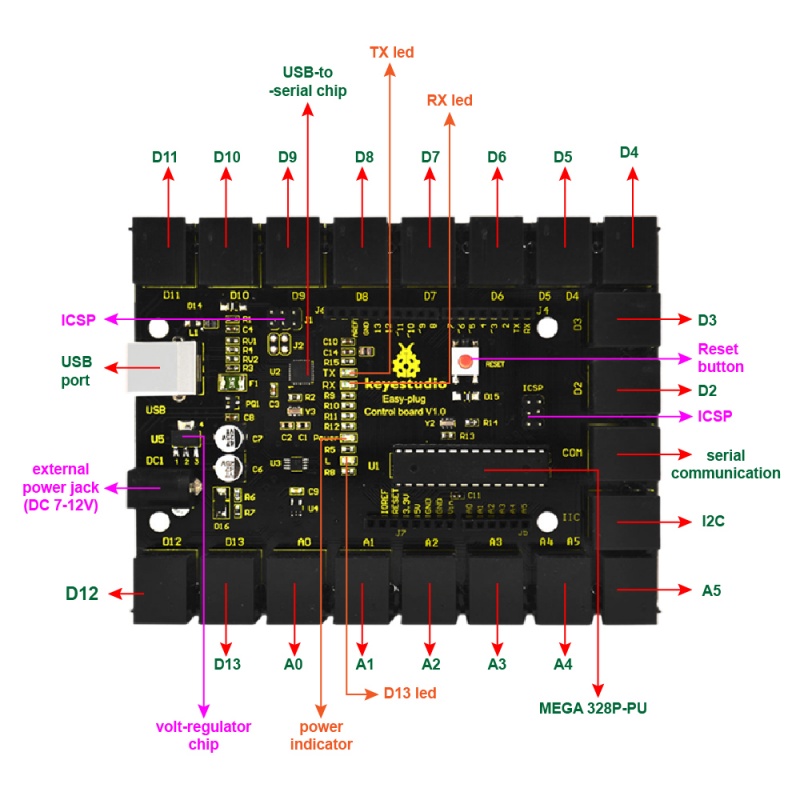
Specialized Functions of Some Pins
- SPI communication: D10 (SS), D11 (MOSI), D12 (MISO), D13 (SCK).
- IIC communication: A4 (SDA); A5(SCL)
- Serial communication: Digital pins 0 (RX) and 1 (TX).
- PWM (Pulse-Width Modulation): D3, D5, D6, D9, D10, D11
- External Interrupts: D2 (interrupt 0) and D3 (interrupt 1). These pins can be configured to trigger an interrupt on a low value, a rising or falling edge, or a change in value.
- SPI communication: D10 (SS), D11 (MOSI), D12 (MISO), D13 (SCK). These pins support SPI communication using the SPI library.
- IIC communication: A4 (SDA); A5(SCL)
Detailed Use with ARDUINO Software as follows:
Step1 | Download the Arduino environment (IDE)
When you get the board, first you should install the Arduino software and driver.
We usually use the Windows software Arduino 1.5.6 version. You can download it from the link below:
https://www.arduino.cc/en/Main/OldSoftwareReleases#1.5.x
Or you can browse the ARDUINO website to download the latest version from this link, https://www.arduino.cc, pop up the following interface.
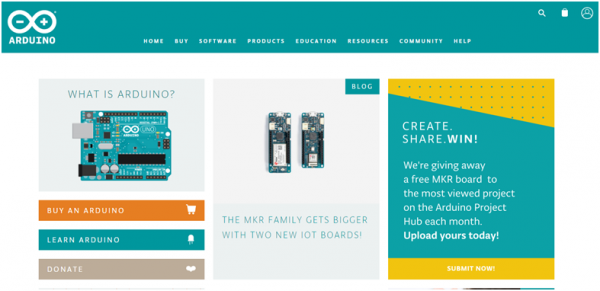
Then click the SOFTWARE on the browse bar, you will have two options ONLINE TOOLS and DOWNLOADS.
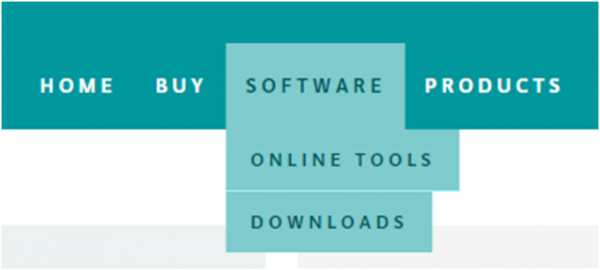
Click DOWNLOADS, it will appear the latest software version of ARDUINO 1.8.5 shown as below.
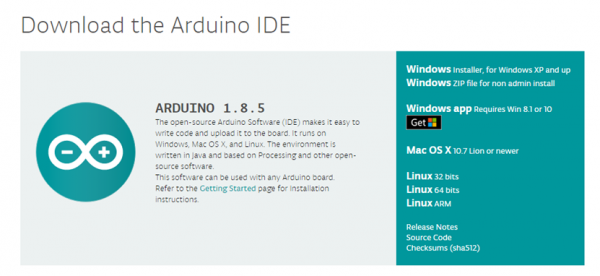
In this software page, on the right side you can see the version of development software for different operating systems. ARDUINO has a powerful compatibility. You should download the software that is compatible with the operating system of your computer.
We will take WINDOWS system as an example here. There are also two options under Windows system, one is installed version, the other is non-installed version.
For simple installed version, first click Windows Installer, you will get the following page.
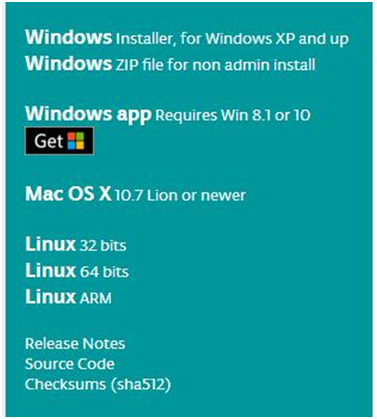
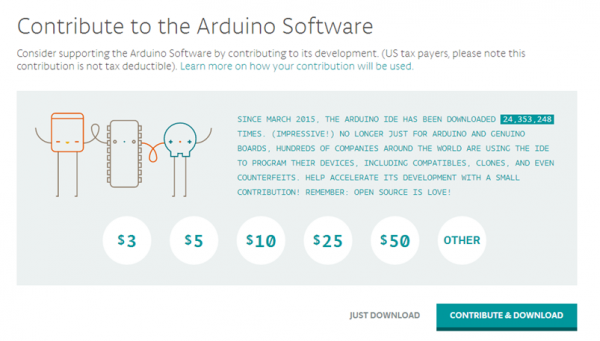
This way you just need to click JUST DOWNLOAD, then click the downloaded file to install it.
For non-installed version, first click Windows ZIP file, you will also get the pop-up interface as the above figure.
Click JUST DOWNLOAD, and when the ZIP file is downloaded well to your computer, you can directly unzip the file and click the icon of ARDUINO software to start it.
Installing Arduino (Windows)
Install Arduino with the exe. Installation package downloaded well.
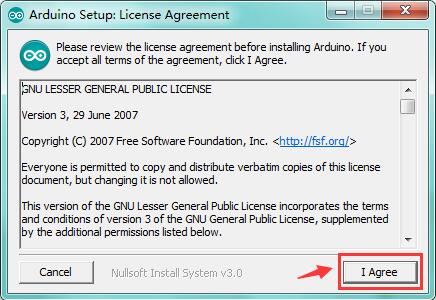
Click“I Agree”to see the following interface.
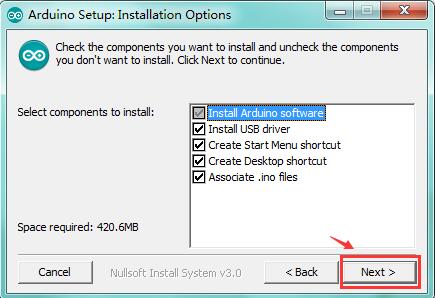
Click “Next”. Pop up the interface below.
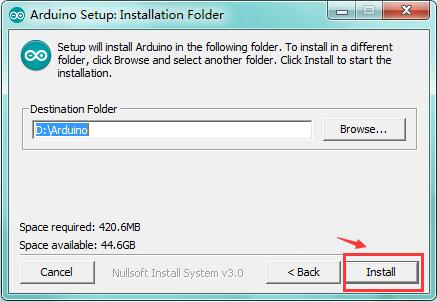
You can press Browse… to choose an installation path or directly type in the directory you want.
Then click “Install” to initiate installation.
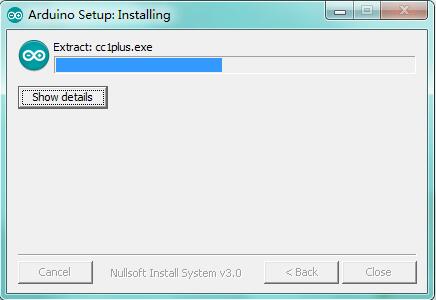
Wait for the installing process, if appear the interface of Window Security, just continue to click Install to finish the installation.
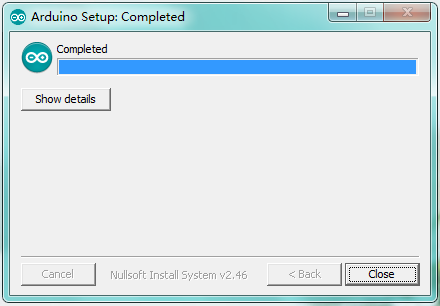
Introduction for Arduino IDE Toolbar
Double-click the icon of Arduino software downloaded well, you will get the interface shown below.

(Note: if the Arduino software loads in the wrong language, you can change it in the preferences dialog. See the environment page for details.)
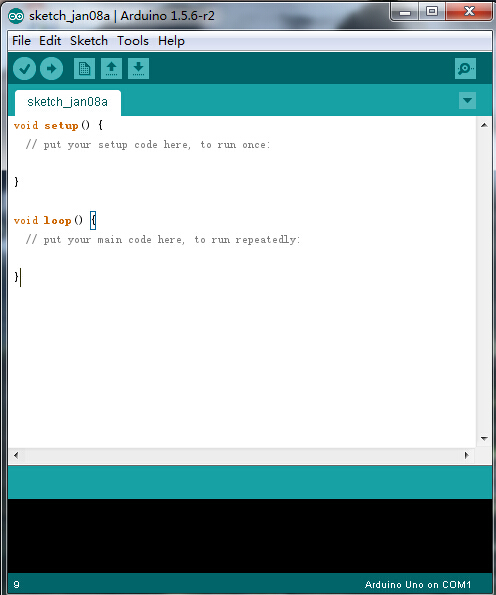
The functions of each button on the Toolbar are listed below:
![]()
Installing Driver
Next, we will introduce the driver installation of board. The driver installation may have slight differences in different computer systems. So in the following let’s move on to the driver installation in the WIN 7 system.
The Arduino folder contains both the Arduino program itself and the drivers that allow the Arduino to be connected to your computer by a USB cable. Before we launch the Arduino software, you are going to install the USB drivers.
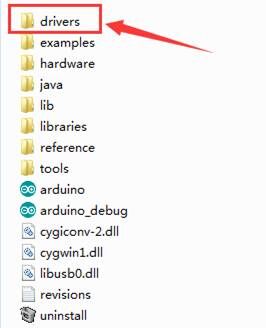
Plug one end of your USB cable into the Arduino and the other into a USB socket on your computer.
When you connect the board to your computer at the first time, right click the icon of your “Computer” —>for “Properties”—> click the “Device manager”, under “Other Devices”, you should see an icon for “Unknown device” with a little yellow warning triangle next to it.
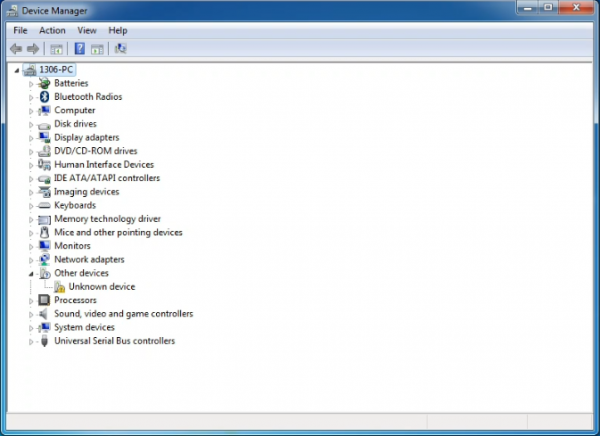
Then right-click on the device and select the top menu option (Update Driver Software...) shown as the figure below..
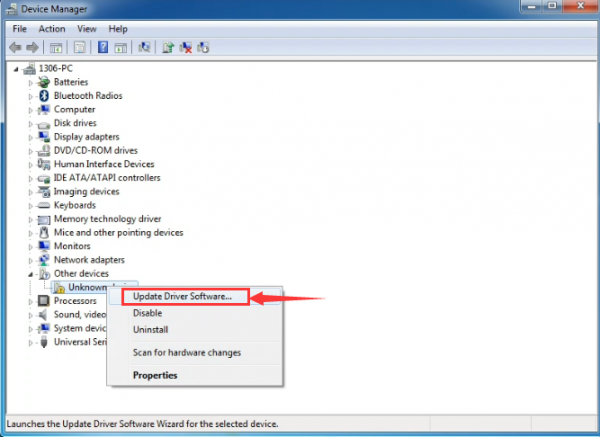
It will then be prompted to either “Search Automatically for updated driversoftware” or “Browse my computer for driver software”. Shown as below. In this page, select “Browse my computer for driver software”.
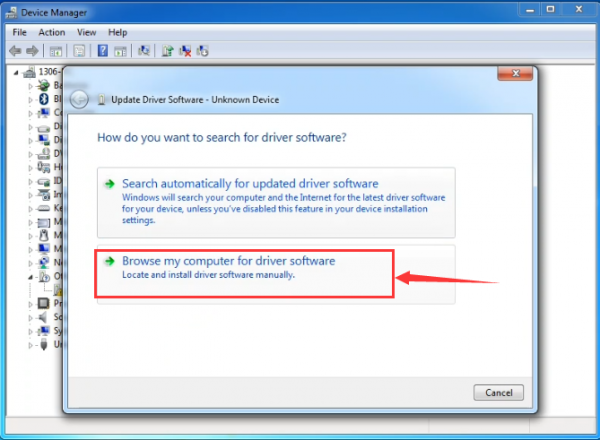
After that, select the option to browseand navigate to the “drivers” folder of Arduino installation.
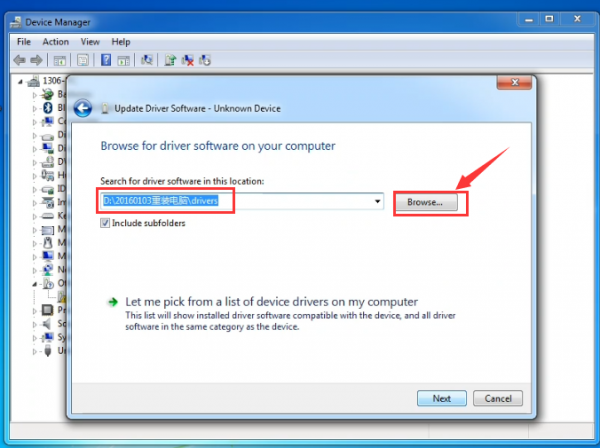
Click “Next” and you may get a security warning, if so, allow the software to be installed. Shown as below.
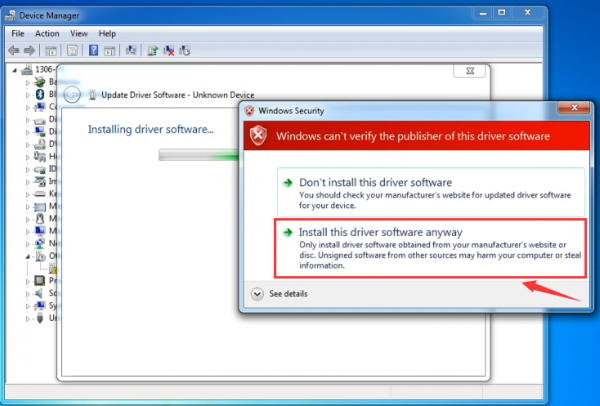
Once the software has been installed, you will get a confirmation message. Installation completed, click “Close”.
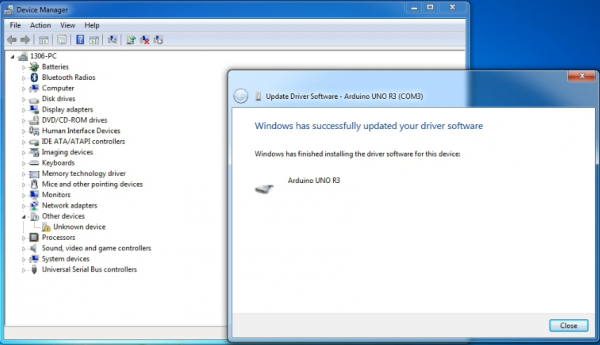
Up to now, the driver is installed well. Then you can right click “Computer” —>“Properties”—>“Device manager”, you should see the device as the figure shown below.
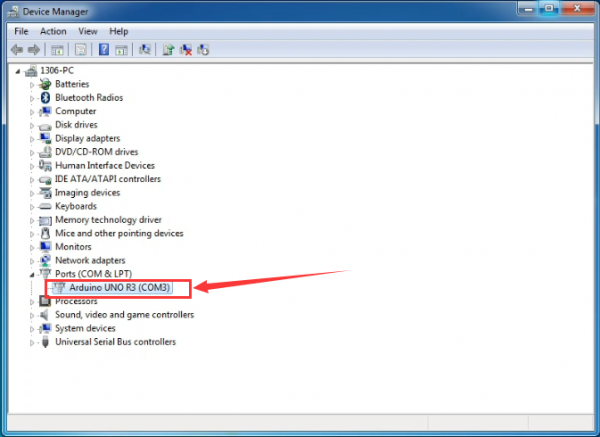
Step2| Connect the board
Connect the control board to your computer using the USB cable. The power LED should go on.
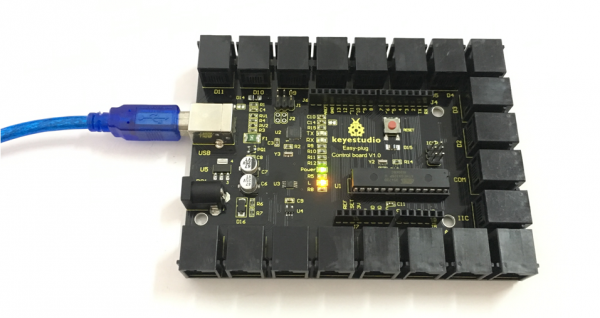
Step3| Select the Arduino Board
Open the Arduino IDE, you’ll need to click the “Tools”, then select the Board that corresponds to your Arduino.

Step4| Select the Serial Port
Select the serial device of the Arduino board from the Tools|Serial Port menu.
Note: to avoid errors, the COM Port should keep the same as the Ports shown on Device Manager.
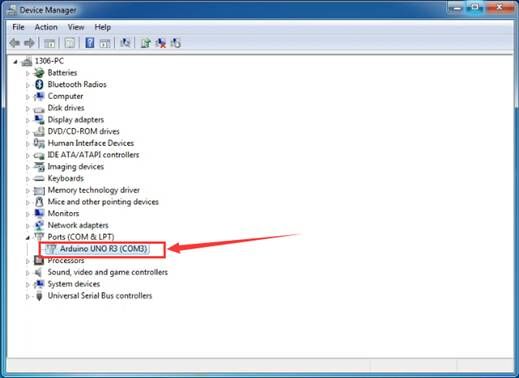

Step5| Upload the Code
Below is an example code for displaying the Hello World! Copy and paste the code to the Arduino environment IDE.
int val;
int ledpin=13
void setup()
{
Serial.begin(9600);
pinMode(ledpin,OUTPUT);
}
void loop()
{
val=Serial.read();
if(val=='R')
{
digitalWrite(ledpin,HIGH);
delay(500);
digitalWrite(ledpin,LOW);
delay(500);
Serial.println("Hello World!");
}
}
Then click verify button to check the errors. If compiling successfully, the message "Done compiling." will appear in the status bar.
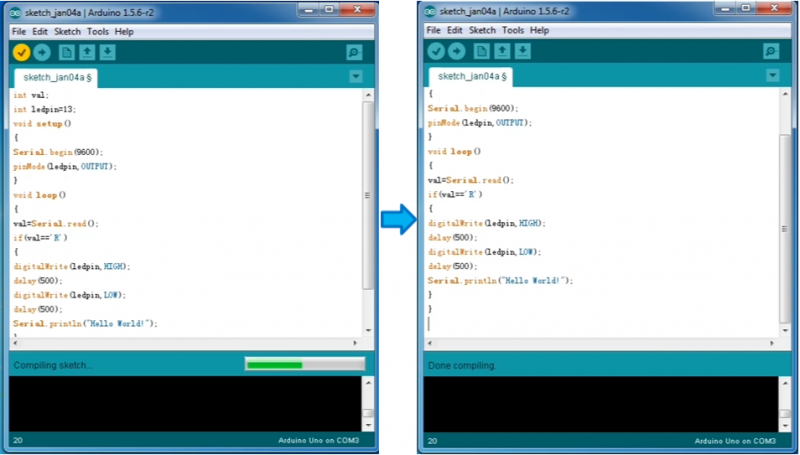
After that, click the “Upload” button to upload the code. Wait a few seconds - you should see the RX and TX leds on the board flashing. If the upload is successful, the message "Done uploading." will appear in the status bar. (Note: If you have an Arduino Mini, NG, or other board, you'll need to physically present the reset button on the board immediately before pressing the upload button.)
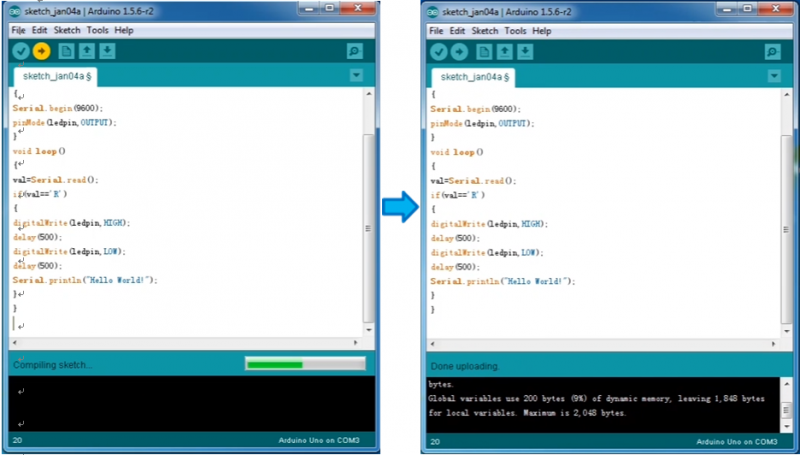
Step6| Open the Serial Monitor
After that, click the serial monitor button to open the serial monitor.
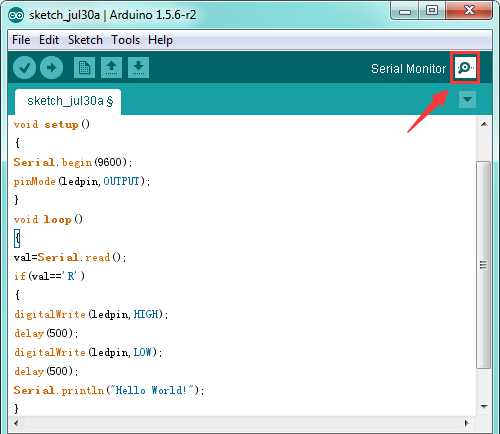
Then set the baud rate as 9600, enter an “R” and click Send, you should see the RX led on the board blink once, and then D13 led blink once, finally "Hello World!" is showed on the monitor, the TX led blink once. Congrats!
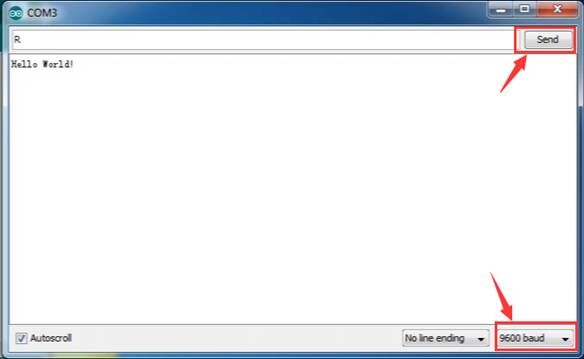
Resource Links
You can download the datasheet from the link:
https://drive.google.com/open?id=1zEpquOTrbcTxPcuGgaGnr5nD8Nsa6zwt
You might also want to look at:
the reference for the Arduino language;
Download ARDUINO Software:
https://www.arduino.cc/en/Main/OldSoftwareReleases#1.5.x
Troubleshooting
If you have problems, please see the troubleshooting suggestions.
Package Included
- Keyestudio Easy plug control board V1 * 1pcs
- USB cable * 1pcs
- RJ11 6P6C connector wire * 1pcs
